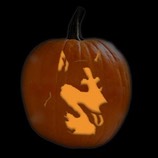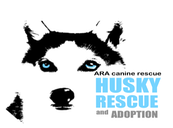Halloween: Along with all the ghouls and ghosts are some seasonal
concerns that you should prepare for.
We all know that huskies escape! A procession of trick or treaters at the door means that your hairy Houdini will have plenty of opportunities to get out. Make sure that you keep your pet in a secure area during the trick and treating, away from all the candy, junk food and decorations that are associated with Halloween.
Make sure that your husky has a collar and tag on and get them micro-chipped so that in the event that your husky makes a bolt for it you have a better chance of getting them home safely.

Don’t force your pet to wear a costume if your pet shows obvious signs of stress or fear. It may be funny for you but for your dog it is not. Many of the body paints that are sold are also toxic if swallowed so don’t use these body paints on your pets...they constantly groom themselves and will lick and ingest it.
DOWNLOAD The stencil for this pumpkin HERE
If you take your dog trick or treating with you, make sure that people do not feed your pet junk food. Have a pocketful of dog treats so that the children can give them to your pet instead.
These foods commonly around at Halloween are toxic for dogs:
Chocolate. Chocolate contains theobromine and caffeine, both of which can affect a dog's heart and central nervous system. Chocolate can be fatal to a dog if they eat enough of it. Note that darker chocolate is more dangerous than milk chocolate. White chocolate has the lowest level of methylxanthines, while baking chocolate contains the highest. Chocolate can also cause pancreatitis which can be very serious.
Salty Snack Foods. Large amounts of salt can produce excessive thirst and urination, or even sodium ion poisoning in pets. Signs that your pet may have eaten too many salty foods include vomiting, diarrhea, depression, tremors, elevated body temperature, seizures and even death. As such, we encourage you to avoid feeding salt-heavy snacks like potato chips, pretzels, and salted popcorn to your pets.
Gum. If your dog has eaten gum, check the package to see if it contains "xylitol". Xylitol is very toxic to dogs.
FYI Xylitol is showing up in many sugar-free foods including some peanut butters so please check the labels.
Macadamia nuts. Dogs will develop weakness and an inability to walk, specifically in their hind legs. Vomiting, staggering gait, depression, tremors and hypothermia.
Raisins (and grapes). They can affect the kidneys, yet many dogs can eat raisins and never have a problem. If your dog eats one or two raisins, look for signs of vomiting and an increase in thirst and urination. If vomiting occurs then go see the vet. If your dog has eaten a lot of raisins, take it to the vet immediately.
Garlic. Garlic is toxic to your dog because it can damage their red blood cells. A small amount of garlic may not cause any observable symptoms, but will still damage some of your dog's red blood cells. If your dog eats a lot of garlic, or eats garlic every day, they can become anemic (low red blood cell count).
(this info is not intended to be used as an alternative to medical advice. We are not vets.)

